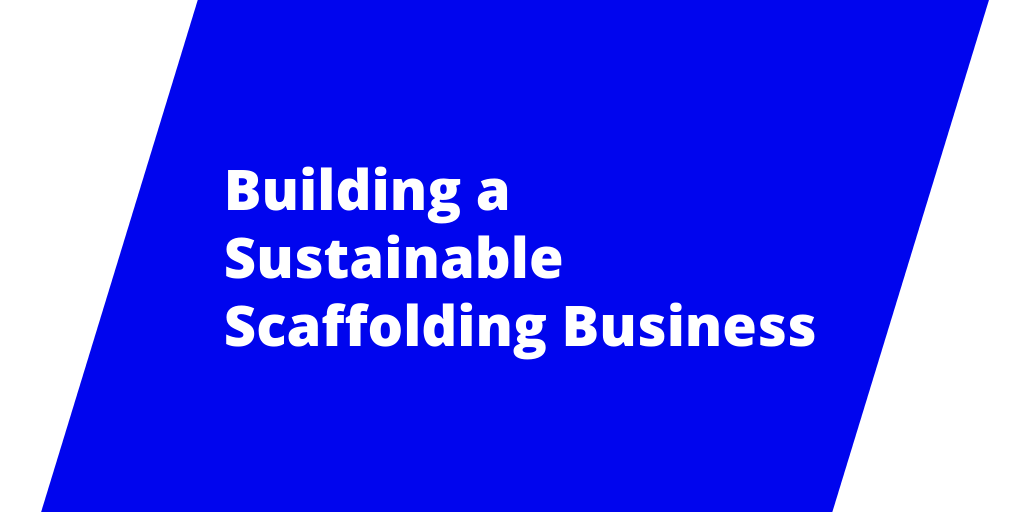From Bid to Build: How Scaffolding Software Supports Every Step of Scaffolding Projects
In today’s construction landscape, digital tools are reshaping how scaffolding companies operate—from the initial bid to project closeout. As the… Read More
Your Site Without Guesswork: ScaffoldIQ Webinar | Nov. 4 at 10 AM AWST, Nov. 5 at 11 AM GMT, Nov 6. At 9 AM PST | Register

While the word “sustainability” is recently trending amongst activists and businesses alike, it is not just a flavor of the month.
We can define sustainability different ways. In the scaffolding industry, we believe that sustainable scaffolding concerns the efficiency and optimization of resources. By that, we mean the resources currently being expended on the design process and materials.
Addressing this issue is especially important for the scaffolding industry because scaffolding is currently one of the most wasteful construction costs out there.
Unfortunately, most scaffolding companies are unaware of why sustainability initiatives are important, or what they look like in practice. It’s a shame because adopting these initiatives can really help improve business productivity and profitability over the long run.
That is why we’re sharing a few indicators your scaffolding business isn’t as sustainable as it should be and how you can turn it around.
Do you find your employees hunched over their desks designing scaffolds with good ol’ pen-and-paper like it’s still the 80s?
Are your employees twisting themselves in knots trying to figure out the complexity of non-industry-specific design software like AutoCAD?
Is design handover generally a hassle due to the lack of cohesion and the difficulties keeping track of design changes?
If so, you’re in a tough spot.
Best-case scenario, you only take a financial hit by losing out on bids because of how long and how much it costs you to generate an estimate.
Worst-case scenario, accidents happen due to human error and the lack of design security checks in the process. Staff productivity and morale takes a nosedive, you have to pay fines, and your reputation is negatively affected.
You keep track of your scaffolding inventory with multiple Excel spreadsheets with data, formulas, and tables that have not been updated in forever, which is actively hurting your business.
As a result, you constantly make mistakes like not sending out enough materials (or sending too much) for your jobs, which leads to you expending more resources to fix those mistakes.
You also find it hard to keep track of your materials as they move between job sites and your storage. You constantly see shortfalls in your stock because customers aren’t returning your materials on time.
While these problems might seem minor, they will eventually take a toll on the profitability and productivity of your company.
If you see these signs, don’t worry. Here are two ways to make your scaffolding business more sustainable.
With the advances in technology these days, industry-specific scaffolding software can do more than ever.
How about an interface that allows you to drag-and-drop your built-in, fully customizable designs? One where you can import even the most complicated building plans and add scaffolds within minutes?
How about going for scaffold designs that can be rendered in a professional 3D model?
How about visualizing your scaffold designs in AR/VR using Avontus Viewer®, which allows you to easily review and confirm the safety and accuracy of your drawings?
You can experience all these capabilities and more with Avontus Designer®, an award-winning scaffolding software that will put your company on the right track to sustainability by optimizing the design process for both safety and efficiency.
One benefit of an automated inventory management system is the optimization of your time and materials via clarity and centralization.
An ideal system should not only keep you aware of exactly what you own and where it is located at all times.
It should also empower you to manage every scaffold from start to finish by generating estimates, monitoring inventory, shipping materials, generating invoices, managing re-rentals, etc. all in one place.
This can help you maximize utilization while avoiding shortfalls.
With Avontus Quantify®, you can do all that and more. Without wasting precious resources on minor hindrances, your company will be more sustainable AND profitable in the long run.
As mentioned above, scaffolding businesses should embrace sustainability to continue flourishing in a competitive business landscape.
If your scaffolding business is showing the signs mentioned above, your business is not very sustainable.
You can put your scaffolding business on the path to sustainability in the following ways: digitalizing the scaffolding design process and automating their inventory management.
Find out how you can do that with our award-winning solutions below!